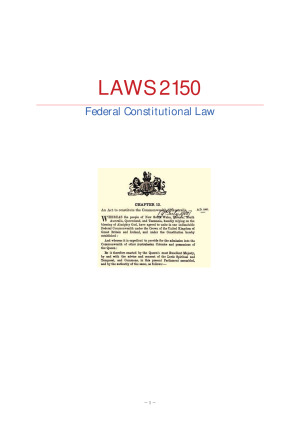LAWS 2150 Federal Constitutional Law Class Notes
Subject notes for UNSW LAWS2150
Description
LAWS 2150 Federal Constitutional Law – 1 – Contents Contents 2 Class 1A: The Constitution 6 Recent Developments in Federal Constitution Law 6 Covering Clauses 6 Chapter I: The Parliament 7 Part I: General 7 Part II: The Senate 7 Part III: The House of Representatives 8 Part IV: Both Houses of the Parliament 8 Part V: Powers of the Parliament 9 Chapter II: The Executive Government 11 Chapter III: The Judicature 11 Chapter IV: Finance and Trade 12 Finances of the Commonwealth 12 Customs and Exercise Duties 13 Commonwealth Finances and the States 13 The Inter-State Commission 13 State Debts 14 Chapter V: The States 14 States’ Legal Systems 14 Prohibitions, Rights and Duties 14 Chapter VI: New States 15 Chapter VII: Miscellaneous 15 Class 1B: Constitutional Interpretation (I) 17 Pre-Engineers Case (p 242) 17 Implied Immunity of Instrumentalities (p 243) 17 Reserved State Powers (p 248) 18 Engineers’ Case and End of Implied Immunity and Reserve State Power 19 The Jumbunna Principle (p 182) 20 Class 2A: Constitutional Interpretation (II) 21 Literalism, Legalism and Judicial Choice (p 170) 21 The Dead Hand and the Living Tree (p 186) 23 Use of Historical Materials (p 186) 23 Originalism: Intention of the Framers (p 186) 24 Textualism (p 192) 24 Incremental Accommodation (p 196) 25 Purposive Interpretation: Constitution as a Living Tree (p 199) 26 Strategic Compromise (p 207) 28 Class 2B: Characterisation 30 Characterisation (p 760) 30 Dual Characterisation (p 764) 30 Interaction between Heads of Power (p 773) 32 – 2 – Subject Matter and Purpose Powers (p 778) 33 Subject Matter Powers (p 779) 33 Sufficient Connection (p 779) 33 Role of Purpose (p 785) 34 Incidental Powers (p 786) 35 Purpose Powers and Proportionality (p 788) 35 Purpose Powers (p 788) 35 Extending the Purpose Test beyond Purpose Powers (p 790) 36 Proportionality and Constitutional Limitations (p 799) 37 Class 3A: Other Fundamentals 39 Precedent and Overruling Constitutional Cases (p 480) 39 UK Position 39 HCA Position 39 Reading Down and Severance (p 473) 41 Classes 3B–4A: External Affairs 44 Relations with Other Countries (p 896) 44 Matters External to Australia (p 898) 44 International Law Other than Treaties (p 902) 45 Implementing Treaties (p 903) 45 Entering into Treaties (p 903) 45 First Approaches to Treaties and s 51(xxix) 46 The Expanding Power (p 908) 46 Confirmation of the Expanding External Affairs Power (p 919) 48 International Recommendations (p 926) 48 Classes 5A–5B: Economic Powers 50 Trade and Commerce Power (p 802) 50 Scope of the Trade and Commerce Power (p 802) 50 Incidental Powers Relating to Trade and Commerce (p 806) 51 Corporations Power 52 Development of the Corporations Power (p 815) 52 1. Constitutional Corporations (p 818) 52 2. Activities Covered by s 51(xx) (p 828) 54 Classes 6A–6B: Races Power 57 History of the Races Power (p 986) 57 Commonwealth Power with Respect to Aboriginal People (p 987) 57 Special Laws Deemed Necessary for People of Any Race (p 989) 57 For the Benefit of a Race (p 997) 58 Constitutional Recognition of Indigenous People 60 Class 8B(1): Taxation Power 62 Procedure for Passing Tax Bills (p 1010) 62 Meaning of ‘Tax’ (p 1011) 62 Fee for Services (p 1018) 64 Class 8B(2): Grants Power 65 The Early Cases (p 1067) 65 – 3 – The Uniform Tax Cases (p 1069) 65 First Uniform Tax Case 65 Second Uniform Tax Case 65 Limits on the Grants Power (p 1077) 66 Class 9A: Inconsistency of Laws 68 ‘Invalid’ and ‘Prevail’ (p 297) 68 Tests of Inconsistency (p 298) 68 Direct Inconsistencies (Categories 1–2) 68 Indirect Inconsistencies (Category 3) 69 Applying the Categories of Inconsistency 69 Operational Inconsistency (p 309) 70 Manufacturing Inconsistency and Consistency (p 310) 70 Manufacturing Inconsistency (p 311) 71 Manufacturing Consistency (p 321) 72 Provision That Federal Law Does Not Limit Concurrent State Law 72 Rollback Provision (p 322) 72 Class 9B: The Commonwealth and the States 74 The Melbourne Corporation Principle (p 1084) 74 Melbourne Corporation (1947) CLR 74 Victoria v Commonwealth (1971) CLR (‘Payroll Tax Case’) 74 Restatement I: Two Principles 74 Restatement II: One Principle 76 Classes 10A–10B: Freedom of Interstate Trade and Commerce 78 Background to the Freedom of Interstate Trade and Commerce (p 1195) 78 The Bank Nationalisation Case (p 1198) 78 Cole v Whitfield (1988) CLR (The Court) 79 Freedom of Interstate Intercourse 79 Freedom of Interstate Trade and Commerce 79 Developments since Cole v Whitfield 79 Class 11A: Express Guarantees 82 Trial by Jury (p 1156) 82 Freedom of Religion (p 1173) 83 Laws for Prohibiting Free Exercise of Religion 83 Laws for Establishing Any Religion 84 Religious Qualification for Office under the Commonwealth 84 Classes 11B–12A: Implied Freedom of Political Communication 85 Origins of the Implied Freedom of Political Communication 85 Developments since Australian Capital Television 86 Confirming the Implied Freedom: Lange v ABC (1997) CLR 87 Protest and the Implied Freedom 88 Lange’s Two Questions 88 Effective Burden on Government/Political Communication 89 Legitimate Ends and Proportionate Means 89 Classes 12B–13A: Judicial and Non-Judicial Detention 91 – 4 – Non-Judicial Detention at the Commonwealth Level (p 541) 91 Non-Judicial Detention at the State Level: The Incompatibility Doctrine 91 Kable v Director of Public Prosecutions (NSW) (1996) CLR 91 Nature of Judicial Orders: NSW v Kable (2013) CLR 92 Preventive Detention (p 574) 92 Protective Detention (p 554) 93 Immigration Detention (p 557) 94 The Al-Kateb Trilogy 94 Chu Kheng Lim vs Al-Kateb 94 Control Orders (p 589) 96 Federal Anti-Terrorism Legislation 96 State Anti-Bikie Legislation 97 Extension: Defence Power 98 Nature and Scope of the Defence Power (p 845) 98 War (p 847) 99 Post-War (p 854) 100 Peace (p 856) 100 Defence Power during the Cold War (p 863) 100 Terrorism and National Security (p 876) 102
UNSW
Term 1, 2019
102 pages
44,370 words
$59.00
1
Campus
UNSW, Kensington
Member since
September 2020
